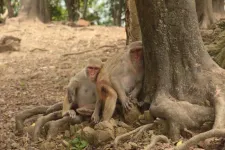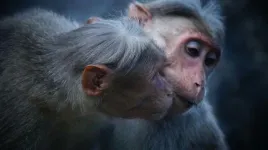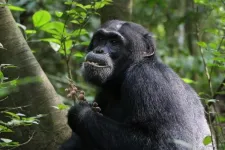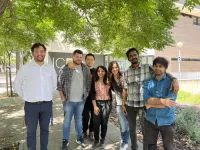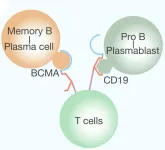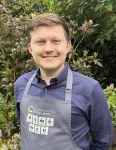(Press-News.org) Analysis of radiocarbon produced during nuclear bomb testing in the 1960s suggests that current Earth system models underestimate carbon uptake into terrestrial vegetation and soils. But, say the study’s authors, this storage is more short-lived than previously thought. The findings suggest that anthropogenic carbon dioxide will not reside as long in the terrestrial biosphere as models currently predict. Accurate climate predictions, crucial for developing effective climate policies, require a robust representation of the global carbon cycle. It’s thought that vegetation and soils account for taking up approximately 30% of anthropogenic carbon dioxide (CO2) emissions, yet the processes underlying the net CO2 sink into the terrestrial biosphere are poorly constrained. This is particularly true for processes involved in global net primary productivity (NPP) – the rate at which plants produce new tissues from atmospheric CO2 – and for carbon turnover rates. Current NPP estimates vary widely due to reliance on statistical or model-based predictions and limited site-scale measurements. Nuclear bomb testing in the 1950s and 1960s increased atmospheric radiocarbon (14C), which was absorbed by the terrestrial biosphere. Tracking the accumulation of bomb radiocarbon in the biosphere post-nuclear testing could help evaluate NPP and carbon turnover rates. However, direct observation of global 14C accumulation has been a challenge. Heather Graven and colleagues address this by combining a new budget of radiocarbon produced by nuclear bombs with model simulations to provide a top-down constraint on global NPP for the 1960s (1963 to 1967). Graven et al. found that current models underestimate the magnitude of NPP in the 1960s. According to the findings, NP in the 1960s was at least 63 petagrams of carbon per year (PgC/yr), which implies a current rate of 80PgC/yr given increases in productivity over time. This is more than the 43 to 76 PgC/yr that current models predict. Graven et al. argue that this discrepancy is due to underestimating the carbon stored in short-lived or non-woody plant tissues. “Because the uptake and turnover of carbon are the main controls on the anthropogenic CO2 sink in the terrestrial biosphere, the results of our study suggest that the storage of anthropogenic carbon in the terrestrial biosphere is likely more short-lived and more vulnerable to future changes than previously thought,” Graven et al. write.
END
Old bombs reveal new insights: Plants store more carbon, but for a shorter time frame, than we thought
2024-06-20
ELSE PRESS RELEASES FROM THIS DATE:
The time it takes a person to decide can predict their preference
2024-06-20
Researchers led by Sophie Bavard at the University of Hamburg, Germany, found that people can infer hidden social preferences by observing how fast others make social decisions. Publishing June 20th in the open-access journal PLOS Biology, the study shows that when someone knows the options being considered by another person, and they know how long it takes them to reach their decisions, they can use this information to predict the other person’s preference, even if they do not know what the actual choices were.
How do we know what someone’s social preferences ...
Hurricane changed ‘rules of the game’ in monkey society
2024-06-20
A devastating hurricane transformed a monkey society by changing the pros and cons of interacting with others, new research shows.
Hurricane Maria hit Puerto Rico in 2017, killing more than 3,000 people. It also destroyed 63% of vegetation on Cayo Santiago (also known as Monkey Island), which is home to a population of rhesus macaques.
Even now, tree cover remains far below pre-hurricane levels and – in this hot part of the world – that makes shade a scarce and precious resource for the macaques.
The new study, led by the universities of Pennsylvania and Exeter and published in the journal Science, shows the storm ...
Researchers widely observe yet seldom publish about same-sex sexual behavior in primates and other mammals - often because it is perceived to be rare
2024-06-20
Researchers widely observe yet seldom publish about same-sex sexual behavior in primates and other mammals - often because it is perceived to be rare
###
Article URL: https://journals.plos.org/plosone/article?id=10.1371/journal.pone.0304885
Article Title: Same-sex sexual behaviour among mammals is widely observed, yet seldomly reported: Evidence from an online expert survey
Author Countries: Canada, USA
Funding: The authors received no specific funding for this work. END ...
Wild chimpanzees seek out medicinal plants to treat illness and injuries
2024-06-20
Chimpanzees appear to consume plants with medicinal properties to treat their ailments, according to a study publishing on June 20 in the open-access journal PLOS ONE by Elodie Freymann from the University of Oxford, UK, and colleagues.
Many plants produce compounds that have medicinal effects on humans and other animals. Wild chimpanzees eat a variety of plant matter, including some that is nutritionally poor but may treat or lessen the symptoms of illness. However, it is hard to determine whether chimpanzees self-medicate, by intentionally seeking out plants with properties that help their specific ailments, or passively consume plants ...
New catalyst unveils the hidden power of water for green hydrogen generation
2024-06-20
Hydrogen is a promising chemical and energy vector to decarbonize our society. Unlike conventional fuels, hydrogen utilization as a fuel does not generate carbon dioxide in return. Unfortunately, today, most of the hydrogen that is produced in our society comes from methane, a fossil fuel. It does so in a process (methane reforming) that leads to substantial carbon dioxide emissions. Therefore, the production of green hydrogen requires scalable alternatives to this process.
Water electrolysis offers a path to generate green hydrogen which can be ...
Supermassive black hole appears to grow like a baby star
2024-06-20
Supermassive black holes pose unanswered questions for astronomers around the world, not least “How do they grow so big?” Now, an international team of astronomers, including researchers from Chalmers University of Technology in Sweden, has discovered a powerful rotating, magnetic wind that they believe is helping a galaxy’s central supermassive black hole to grow. The swirling wind, revealed with the help of the ALMA telescope in nearby galaxy ESO320-G030, suggests that similar processes are involved both in black hole growth and the birth of stars.
Most galaxies, including our own Milky Way have a supermassive black hole at their centre. How ...
Early detection crucial in bile duct cancer for patients with rare liver disease
2024-06-20
Primary sclerosing cholangitis (PSC) is a rare progressive liver disease that damages bile ducts and significantly increases the risk of bile duct cancer, particularly a type called cholangiocarcinoma (CCA). This cancer is aggressive, and curative surgery is uncommon. Liver transplantation is a potential treatment option for some PSC-CCA patients, especially if the cancer is caught early. Early diagnosis is essential for successful treatment.
PSC can affect people of all ages but primarily strikes men in their 30s and 40s. It is often accompanied by inflammatory bowel disease (IBD). The disease can progress to liver failure and increase the risk of colorectal cancer ...
BCMA-CD19 bispecific CAR-T therapy in refractory chronic inflammatory demyelinating polyneuropathy
2024-06-20
This study is led by Professor Junnian Zheng and Ming Shi from the Cancer Institute of Xuzhou Medical University, together with the team of Professor Guiyun Cui and Wei Zhang from the Affiliated Hospital of Xuzhou Medical University. The team reported for the first time using BCMA-CD19 bispecific CAR T cells for treating relapsed/refractory CIDP.
Chronic Inflammatory Demyelinating Polyneuropathy (CIDP) is an uncommon condition with sudden onset symptoms, including nerve damage affecting movement, sensation, speech, breathing, and heart rate. ...
Embryo and organoid models do not threaten the definition of personhood, bioethicist says
2024-06-20
Advances in organoids and embryonic models of human development have the potential to prompt social and existential questions—e.g., what defines human individuality? However, bioethicist Insoo Hyun of Harvard Medical School and the Museum of Science in Boston says that these models have the potential to strengthen rather than weaken the concept of human individuality when considered within the philosophical frameworks of “personhood” and sentience. In a commentary publishing June 20 in the journal Cell, Hyun argues that despite huge advances, we are a long way off from developing technologies that would ...
Great British Bake Off finalist Josh Smalley discusses the parallels between chemistry and baking
2024-06-20
Last year on a Friday evening, chemical biology researcher Josh Smalley was in the lab when he received a call inviting him to appear on the 14th and latest season of The Great British Bake Off. Starting as one of a group of 12 amateur bakers, Smalley made it all the way to the final round, where the top 3 contestants compete for the winning spot. In an essay published in the journal Cell Chemical Biology on June 20, Smalley describes the overlap between chemistry and baking and how his training in one ...

